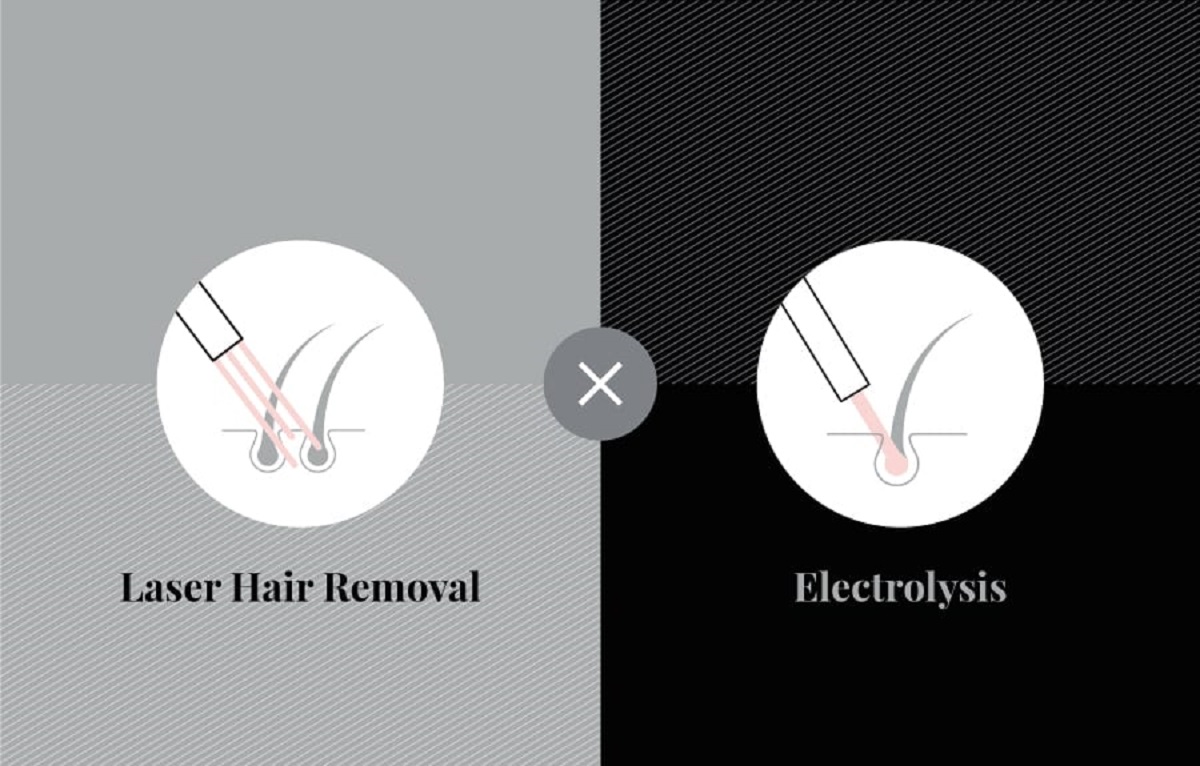
Laser Hair Removal Vs Electrolysis
- Santiago Cooper
- April 13, 2023
- Health, Lifestyle
- 0 Comments
Laser hair removal Vs electrolysis are two FDA-approved permanent hair removal methods. Both are great alternatives to shaving, waxing or repeatedly using depilatories.
The key difference between the two is that laser hair removal can cover a much larger area in fewer treatment sessions than electrolysis. The exact number of sessions depends on your skin type, hair color and pigmentation.
What is Laser Hair Removal?
Laser hair removal is a safe, effective way to eliminate unwanted hair growth. The American Society of Plastic Surgeons reported that it was one of the top five nonsurgical procedures in the United States in 2016.
During treatment, your doctor will use a hand-held laser instrument on your skin. It might have a cooling device or gel on the tip to protect your skin and reduce discomfort during treatment.
What is the procedure?
Laser hair removal is a safe and effective way to remove unwanted facial or body hair. Unlike shaving, waxing and electrolysis, which only remove the surface of the hair and do not affect the root of the hair, laser treatments destroy the hair follicle so that it can no longer grow.
The procedure involves delivering pulses of light to the hair follicle, which absorbs the light and heats up. The laser vaporizes the hair, permanently preventing future growth.
Usually, two to six treatments are needed for maximum results. The interval between sessions depends on the hair’s growth rate.
During the treatment, you might feel discomfort like warm pinpricks or a rubber band snapping against your skin. You may use cold compresses to ease the discomfort. You might also experience an itching sensation after the procedure.
What are the risks of Laser Hair Removal?
Laser hair removal is a type of non-ionising radiation treatment that uses a high-powered laser to damage the growth of your unwanted body hair. It is often used on sensitive areas of the body, such as the face and bikini line.
Some people who have this treatment may experience redness, skin irritation or swelling. These are temporary side effects and should ease within 24 hours.
This is usually due to the intense heat from the laser beam damaging the hair follicles, which can slow down new hair growth and make it more difficult for them to grow back.
The laser beam also can cause your skin to change color, either darkening or lightening. These changes are usually mild and fade over time, and the normal color of your skin will return.
The risks associated with laser hair removal are minimal when performed by a skilled professional. However, the procedure can lead to blistering, crusting or scarring if it is not carried out correctly.
How long will the treatments last?
Laser hair removal is a permanent hair reduction solution that can remove unwanted hair from most parts of the body. However, the results will vary from person to person.
Typically, six treatments spaced about four to eight weeks apart are needed for optimal hair reduction. Each treatment session can take anywhere from a few minutes to an hour, depending on the area treated.
In some cases, a topical numbing gel may be used to make the treatment more comfortable. This will usually be done before the actual procedure.
The number of sessions you need will depend on the coarseness of your hair and your skin color. It is also important to avoid sun exposure prior and after treatments, as it could interfere with the effectiveness of the laser.
Pros and Cons of Laser Hair Removal
Pain
In most cases laser hair removal does not hurt as much as waxing or shaving, but it can feel slightly uncomfortable for some people. This is mainly due to the area being treated and your personal pain tolerance.
Modern laser machines use a constant stream of cool air to reduce the discomfort during treatment. In addition, numbing cream is often used before and after treatment to minimize the discomfort.
During each treatment, pulses of light are delivered to the skin that destroys hair follicles. Once destroyed, hair growth ceases and does not return for months or years.
Laser hair removal can be a safe and effective way to remove unwanted hair from the face, chest, arms, legs, bikini line and other areas of the body. For best results, patients typically need a series of 4-6 treatments spaced six weeks apart on the face and up to eight weeks for other body parts.
Time
Depending on the type of laser used, a hair removal session may take a few minutes or an hour. You might feel a burning sensation as the laser destroys the hair follicle.
You can expect mild redness and swelling around the follicles, which will diminish in a few hours. It’s a good idea to apply an ice pack on the treatment site to help minimize discomfort.
Most people need 6-8 sessions for complete hair removal, spaced 4-8 weeks apart, depending on the area being treated. Since the laser only affects hair follicles that are in the active growth phase, multiple treatments are necessary to effectively reduce all of the unwanted hair in an area.
The most effective lasers for hair removal have a spot size that’s about the size of your fingertip, and they use a fluence that’s high enough to penetrate deeply into your skin and disable the follicles from producing new hair. Those with darker skin tones are more likely to experience hyperpigmentation and burns from the laser, so a consultation is important before the treatment.
Side Effects
Laser hair removal is a safe and effective way to remove unwanted hair. It works by delivering heat to the targeted hair follicles, which then stops them from growing.
The process can cause mild redness, itching and some swelling after the treatment. These are temporary side effects that should clear up within a few hours.
Skin discoloration can also occur, especially on people with a darker skin tone. It’s important to avoid sun exposure prior to and after treatment to prevent the risk of discoloration.
In rare cases, laser hair removal can lead to blistering, crusting, scarring or other changes in the skin texture. This is typically more common in people who tend to scar easily or are exposed to a lot of sun before or after the procedure.
How much will it cost?
Laser hair removal is an effective, permanent solution to unwanted body hair. Unlike shaving or waxing, it will never come back, making it an ideal choice for those who want a sleeker and smoother look.
While laser hair removal costs vary by clinic and area, they generally fall between $125 and $1,000 per session. Each treatment will require multiple sessions to achieve a complete result, which can add up quickly.
The cost of laser hair removal is determined by the type of machine used and where you receive the treatment. The higher-end clinics may use state-of-the-art equipment that offers a quick and painless procedure.
For example, laser hair removal for the face is usually cheaper than that for the legs or arms. This is because the face has fewer hair follicles and requires less power from the lasers. It also has a lower risk of injury because the facial skin is less dense.
What is Electrolysis?
Electrolysis is an FDA-approved permanent hair removal treatment that destroys the growth center of your hair follicle and prevents future regrowth. The procedure can be used to remove unwanted facial and body hair of any color or texture.
An electrologist slides a thin, sterile probe into each follicle and administers heat to destroy the area that provides nutrients for the hair. Once the follicle is destroyed, the hair releases from the follicle and the practitioner can remove it with tweezers.
This chemical reaction is similar to the one that happens when electric current passes through molten sodium chloride. The ions from the molten solution are drawn toward the cathode, and they oxidize to chlorine gas at the anode. Chloride oxidation is more positive than water oxidation because the net voltage (Edegcell) of both reactions is negative.
How Does Electrolysis Work?
The only permanent hair removal method approved by the FDA, electrolysis uses a tiny probe to apply a slight current to your hair follicle. This destroys the follicle and prevents it from growing hair in the future.
The treatment catches hairs in different stages of the growth cycle, and destroys them during the optimum time to remove them. This is why a series of electrolysis treatments can achieve permanent results.
The total number of electrolysis sessions you need depends on the area being treated, how thick or coarse the hair is, and your past hair removal history. Your electrologist will be able to help you calculate the number of treatments you need.
How Long Does Electrolysis Last?
Electrolysis treatments are very tolerable for most people, but it’s not a pain-free experience. Patients can opt for a topical numbing cream before treatment to minimize discomfort.
Some clients report a pricking sensation or heat across the area where the electrode is placed. This feeling often subsides in a few hours, but it can last a couple days for others.
Elise notes that the level of pain during electrolysis depends on a client’s overall pain tolerance and skin sensitivity. She recommends using a numbing cream before treatment, applying ice after, and applying moisturizer to the treated area for a week afterward.
It can take up to 18 sessions spaced three to four weeks apart to completely remove hair from an area. This is because each hair follicle goes through three growth phases—the anagen (growing) phase, the catagen (transitional) phase, and the telogen (resting) phase—and it’s impossible to target each follicle in the same time.
Are Electrolysis Treatments Painful?
Electrolysis is an invasive procedure, but it is also a safe and effective way to remove unwanted hair from most body areas. This includes the eyebrows, upper lip, chin, cheeks, forehead, underarms, arms, bikini line, legs, breasts, and more.
Some people experience a stinging sensation during an electrolysis treatment, but most don’t. This is because the fine probe that your electrologist inserts into the follicle is attached to an electrical current.
Most side effects of an electrolysis session are short-lived and can include redness, swelling, welts, blisters, scabs, dryness, and ingrown hairs. These side effects will subside within a few days after treatment and should not interfere with your life.
Pros and Cons of Electrolysis
Electrolysis is one of the most effective hair removal methods on the market. It can remove unwanted hair from virtually any area on your body, including the eyebrows, lip and chin, torso, bikini line, legs, feet and toes.
But it can be more painful than other options, and you may need a series of sessions before the treatment is complete. It also can cause skin discoloration in some people.
Cost
If you’re looking to get rid of unwanted hair on your face or body, electrolysis is the best option. It is effective on all skin types and hair colors and can be used to remove hair from any area of your body, including the eyebrows.
This is a non-invasive and permanent procedure that doesn’t use harmful chemicals. It can also help inhibit new hair growth.
How much it costs depends on the area you’re treating and how many sessions you need. Most people need multiple appointments, and it can take up to a year and a half for the treatment to be effective.
Electrolysis works by passing an electrical current through water or other conductive liquids (electrolytes) to break down the molecules into hydrogen and oxygen gas. Hydrogen gas is the most common element in the universe, while oxygen is the third most abundant.
Pain
Electrolysis is painful, and depending on your own pain tolerance as well as the area being treated the level of pain can vary. Using a topical numbing cream prior to the session will help to make the process more comfortable.
Many people describe the stinging and pricking sensation as being no worse than a mosquito bite, while others find it more like having a rubber band snapping against their bare skin hard. The level of pain is also relative to the sensitivity of your skin and the quality of hair in the area being treated.
The underlying cause of the pain is that the fine needle used in electrolysis has to be inserted into each follicle, which requires electricity to be discharged. This current causes the H2O molecules in the hair to be oxidized or reduced. The water in the hair follicles then spontaneously breaks apart, causing them to detach from their roots and fall out.
Side effects
Electrolysis is a safe, FDA-approved hair removal method that works for all skin and hair types. Its benefits include permanent results, no recovery time, and a low price tag.
The procedure consists of an electric current passing through a fine needle, which damages the hair follicle and prevents new growth. It is also considered to be one of the most effective methods of permanent hair removal.
During the treatment, some skin may feel irritated or appear red. This usually subsides within a day.
Minor scabbing or blistering may occur after the procedure, especially on sensitive areas such as the face and bikini line. Scabs often disappear after a few days but it is important to avoid scratching them, which can lead to scarring.
Another possible side effect is the appearance of patchy areas of discoloration, which are not uncommon after electrolysis. This usually occurs on people with darker skin tones, or those with more sensitive skin.
Time
Electrolysis is a process that uses an electric current to break down chemically bonded ions. It involves electrodes that are immersed in an electrolyte that contains negatively and positively charged ions.
The ions move towards one electrode, the cathode, while the electrons flow away from the other, the anode. This reaction causes the ions to lose or gain an electron, depending on whether they are reduced or oxidized.
During electrolysis, the rate of production of any product is dependent on the current (the number of electrons that are transferred per unit time) and the duration of the reaction. If you know the rate of the current and how long it flows, then you can calculate the amount of product formed.
For electrolysis to be effective, the electrodes must be able to attract ions of opposite charges. This is usually not possible with solids, so electrolysis is only practical when liquids are used. As a result, the ion removal efficiency increases as the electrolysis time increases.
Read This Article:The science of appearance men’s fashion grooming and lifestyle




